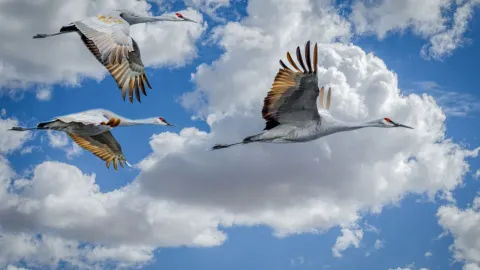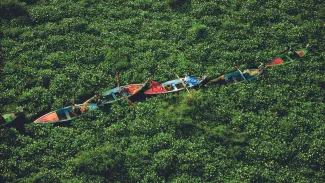
Anne Larigauderie IPBES World Migratory Bird Day 2020 Statement
Statement by Dr. Anne Larigauderie, Executive Secretary of the
Intergovernmental Platform on Biodiversity and Ecosystem Services (IPBES)
on World Migratory Bird Day, 9 May 2020
World Migratory Bird Day – now celebrated both in May and October in recognition of the remarkable cycle of migration – reminds us how birds connect our world, across borders, boundaries and barriers. It also highlights the need for international collaboration to support the protection of species, habitats and local communities around the globe.
As we all struggle today against the effects of the COVID-19 pandemic, it’s worth recalling that the first World Migratory Bird Day was held in 2006 to promote conservation and better understanding amid public fears about the potential role of birds in the spread of a different virus - H5N1, commonly known as bird flu.
The bi-annual commemoration is now celebrated in more than 100 countries and hosted by the secretariats of the Convention on Migratory Species (CMS) and the African-Eurasian Migratory Waterbird Agreement (AEWA), which have worked to raise awareness and foster a global appreciation for migratory species and to promote measures that keep their transcontinental flyways intact.
The IPBES Global Assessment Report, launched last year, noted that: “In the case of migratory birds, intergovernmental efforts to identify flyways and coordinate action have been highly successful” and that, “for most parts of the world, the policies and processes to secure the well-being of flyways is in place, but the challenge lies in implementing them.”
Pressures on migratory species and their habitats have not decreased in recent years, due in large part to changes in the use of land, especially driven by agricultural expansion. This habitat loss impacts nearly 80% of all threatened and near threatened migratory bird species.
Climate change, identified by the Global Assessment as one of the five top direct drivers of biodiversity loss, is also negatively affecting many bird species and this is expected to intensify. An estimated 84% of migratory bird species may be negatively impacted by climate change, which is comparable to the proportion affected by all other human threats. Deforestation and the fragmentation of forests is of particular concern for breeding areas, and other climate-related factors, such as droughts, can also lead to significant declines in non-breeding areas as well.
Protected areas can mitigate some threats facing migratory birds, but just 9% of migratory bird species are adequately covered by protected areas during all stages of their annual cycle, compared to 45% of non-migratory species.
Policy options include mitigating the impacts of infrastructure development which can be implemented through land-zoning that recognizes migratory routes as sensitive areas; another example is adjusting the operation schedule of wind turbines to better protect major groups of migrating birds.
Migratory birds are found everywhere, from parks and cities to mountains and deserts. By way of their journeys, we too are connected to these landscapes and the vibrant ecological systems that underpin our own well-being.
As we shift from ‘business as usual’ due to COVID-19, we increasingly see that changes in the human drivers of biodiversity loss can make space for the other species with which we share habitats and can better protect the contributions of nature to people. Our global interconnectedness, the networks of supply chains of the global economy and our inherent connections with the rest of nature are all highlighted as never before.
World Migratory Bird Day should be a clarion call to listen to the science and implement evidence-informed policies to better protect people and nature.
Enquiries: [email protected]
Follow IPBES and join the conversation online:






